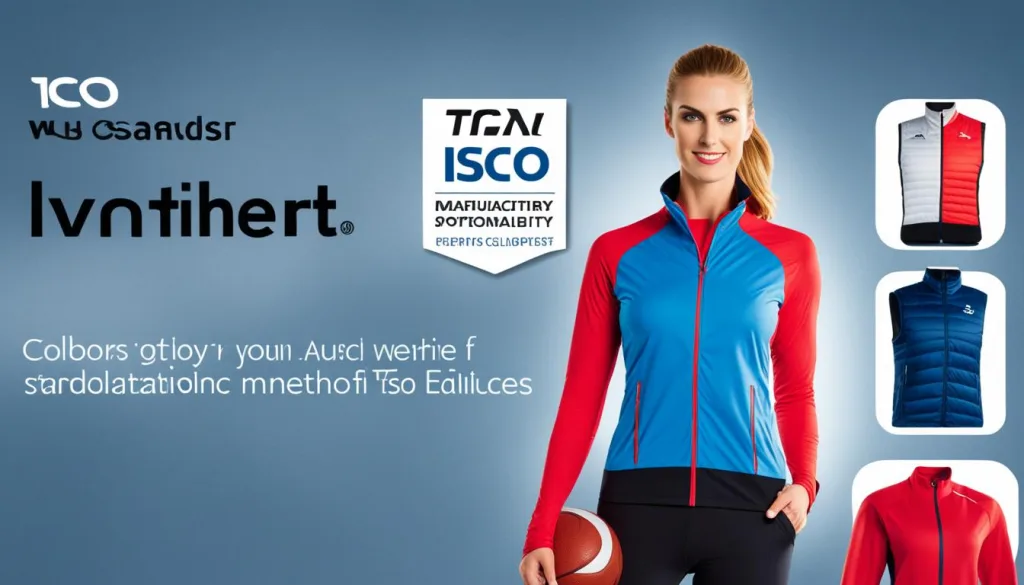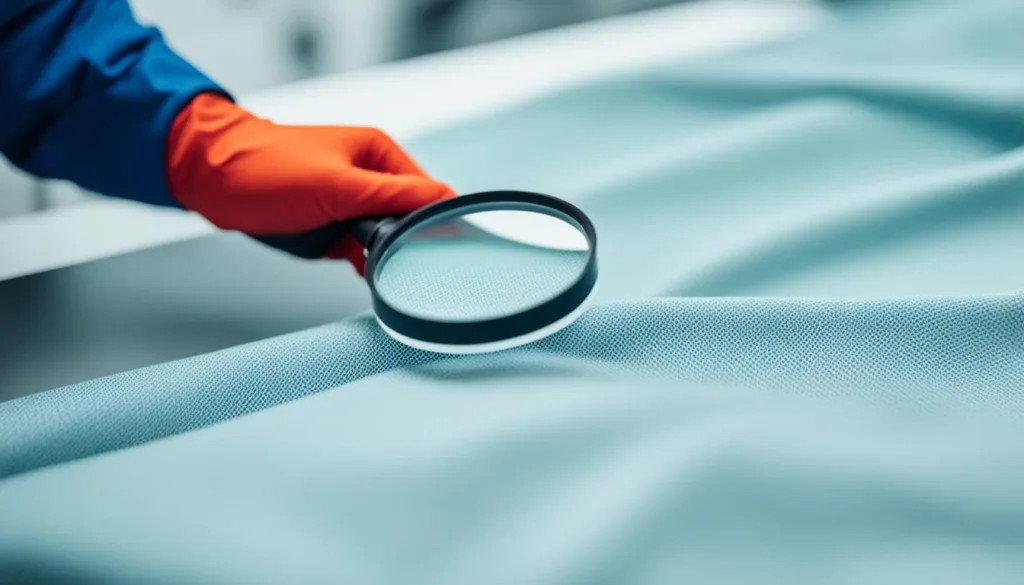ISO Standards: Ensuring Quality and Safety in Sportswear
Connect With Us Today
Consider us for your next production run. Why wait? Send us your questions here.
ISO Standards shape the sportswear industry by setting quality and safety benchmarks. These standards help consumers get top-notch products for their sports needs. They also make sure these products are safe. Following ISO Standards shows a brand’s commitment to making outstanding and safe sportswear.
Sportswear safety merges rules from standards like ASTM D6207 and ISO 6530. This ensures athletes get gear strong enough for physical challenges and the outdoors. Meeting these standards is about more than checking boxes. It’s about proving to customers that their trust in sportswear brands is well-placed. This trust comes from selling gear that’s both tough and safe.
Key Takeaways
- ISO Standards are critical for ensuring high-quality, safe sportswear.
- Adherence to these standards indicates manufacturers’ dedication to product excellence.
- Quality assurance and safety regulations are integral for consumer trust and brand credibility.
- Detailed requirements from ISO and ASTM standards guide sportswear performance evaluations.
- Ensuring safety in sportswear ultimately supports a culture of health and wellness.
The Role of ISO Standards in Sportswear Quality Enhancement
The making and trust in athletic clothes have changed a lot thanks to global safety and quality rules. Making sportswear better needs following ISO Quality Standards. These rules are key for creating high-quality clothes for everyday workouts and pro athletes.
The Definition and Application of ISO Quality Standards in Athletic Apparel
ISO 16321 and ISO 18527 series are leading the way in setting rules for safe and top-quality athletic clothes. They call for tough tests, strong materials, and steady quality in each piece. Moving to these standards means aiming for harmony in sportswear quality worldwide1.
The sportswear market, worth over $45 billion, takes these standards seriously. For brands, following these rules means standing out and being reliable in a field where being creative is also key2.
ISO Certification for Sportswear: Guaranteeing Consistent Quality
For ISO Certification, brands must use standard tests that match ISO rules. Eyewear brands leading the way show how important ISO Certification is. It shows a brand’s dedication to quality, telling customers they can expect the best in their athletic clothes1.
QIMA stands out for helping brands test their products and get ISO Certification. They check everything from the strength of materials to the use of safe dyes. This helps brands not just meet rules but also show their products are safe and high-quality2.
Quality Assurance through ISO Compliant Testing Procedures
The path to top safety and quality in sportswear involves strict ISO testing. Checking fabric performance, colorfastness, and durability are all crucial. These detailed tests are the backbone of ISO Quality Standards, making sure products meet safety and function criteria.
Toshiba is a prime example of following these procedures, earning recognition for its health and safety efforts. With a focus on prevention, both clothing and gear makers can lower the chances of work and product accidents. This is thanks to following ISO Quality Standards3.
| Standard | Purpose | Impact on Sportswear | Compliance Strategy |
|---|---|---|---|
| ISO 16321 and ISO 18527 | Eyewear and face protection | Enhanced safety standards for squash and racquet sports | Integrated manufacturing with standardized test methods |
| ISO Certification | Confirm adherence to ISO Standards | Guarantees consistent quality in sportswear production | Rigorous testing and Quality assurance practices |
| ISO Compliance Testing | Verify quality and safety | Preemptive identification and rectification of product issues | Third-party testing with entities like QIMA |
By closely following ISO Standards, sportswear making reaches new heights in quality and safety. This suits a market that values both athletic achievement and the quality of the clothes that help achieve it.
ISO Standards: Ensuring Quality and Safety in Sportswear
In sportswear, Quality assurance, ISO Standards, and Safety regulations are key. They make sure athletes and consumers are safe. These standards check the clothing from start to finish.
The Importance of Safety Regulations in Performance Wear Certification
Most shoppers want tested sportswear4. Performance wear certification shows a commitment to safety. No matter the sport, certified gear aims to reduce injury risk5.
How ISO Standards Safeguard Athletic Clothing
ISO/TC 83’s Standards cover essential sports safety, from snowsports to martial arts5. Following these Standards boosts customer trust by 25% and lowers risks by 40%4.
Lab tests on sportswear increase safety confidence and reduce risks6. Passing these tests means less complaints4. It proves ISO Standards are vital for protecting sports clothes.
ISO/TR 20183: Guidelines for Injury and Safety Definitions in Sportswear
ISO/TR 20183 sets clear safety standards. It helps define what is safe in sportswear. Various committees use it to make clear guidelines5. This helps shoppers know what to expect from their sportswear.

Lab tests look at many safety aspects6. This approach deals with immediate and long-term safety. It supports the goal of durable and safe sports clothes6.
| Standard Focus | Safety Impact | Consumer Perception |
|---|---|---|
| Fabric Durability | Minimized risk of tearing | Higher satisfaction4 |
| Flame Retardancy | Increased fire resistance | Improved safety trust6 |
| Toxic Substances | Assurance of non-harmful materials | Enhanced product reliability6 |
| Seam Strength | Extended product life | Reduction in complaints4 |
Sportswear guidelines, performance wear certification, and ISO/TR 20183 promote safe sports. ISO Standards play a huge role in safety, improving the sports experience for everyone5.
International Committees and Working Groups behind Sportswear Safety
Keeping sportswear safe and reliable is not simple. It needs the joint work of international committees and specific working groups. These groups are crucial in making standards and rules that ensure sportswear safety. ISO/TC 83’s subcommittees and working groups focus on distinct areas of sports goods. One key group, ISO/TC 83/SC 4, works on snowsports equipment. They push for innovation and safety in gear that needs to be both precise and tough5.

ISO/TC 83/SC 5 and ISO/TC 83/SC 6 make sure ice hockey and martial arts gear are very safe. They use better design and materials to keep athletes safe from harm5. There are many working groups addressing different sports needs. ISO/TC 83/WG 2 works to make camping tents comfortable5.
Meanwhile, ISO/TC 83/WG 6 focuses on spotting hazards and assessing risks. This helps make sports safer for everyone5.
- ISO/TC 83/WG 7 makes sure sleeping bags are safe, giving adventurers peace of mind5.
- Children’s play areas become safer through ISO/TC 83/WG 8’s work on playground equipment5.
- ISO/TC 83/WG 9 helps improve water safety by focusing on floating leisure articles5.
ISO/TC 83’s work covers a lot of sports activities and gear. WG 10 and WG 11 look at sport games and drowning detection systems. They add extra safety for those taking part5. The team works with groups like ISO/TC 188, ISO/TC 228, and ISO/PC 250. These groups share their knowledge on small craft and sustainability in event planning5.
| Working Group | Focus Area | Contribution to Sportswear Safety |
|---|---|---|
| ISO/TC 83/WG 2 | Camping Tents | Enhanced comfort and durability standards |
| ISO/TC 83/WG 6 | Hazard Identification | Methodical risk assessments for sports equipment |
| ISO/TC 83/WG 11 | Submersion Detection | Preventive measures for aquatic sports |
Many working groups also get support from liaisons like IEC/TC 61. They focus on the safety of household appliances used in sports places. ISO/TC 207 works on environmental management. This shows ISO’s commitment to sustainability and toughness in all sports areas5. The World Federation of the Sporting Goods Industry (WFSGI) offers valuable industry insights to these groups5.
The work of these international committees and working groups sets the safety standards for sportswear. ISO plays a key role in promoting top safety standards. It has created 61 standards linked to Sustainable Development Goals5. This helps protect athletes worldwide, continuing a tradition of excellence in sportswear safety and performance.
Performance Wear Certification and Sustainable Development
The link between performance wear certification and sustainable development is getting stronger in sportswear. The sportswear industry follows ISO/TC 83‘s standards closely, marrying eco-friendly methods with the demand for quality and safety.
ISO/TC 83’s Contribution to Sustainable Development Goals
ISO/TC 83‘s efforts are clearly focused on sustainability within sportswear. By setting standards that emphasize sustainable development, they help reduce the industry’s environmental impact. Their approach supports responsible consumption and production, helping sportswear contribute to good health and well-being. The guidelines highlight these sustainable practices.
Quality Education and Gender Equality through Safer Sportswear Design
Improving safer sportswear design means promoting quality education and gender equality. ISO standards make sports more accessible and safe for everyone, breaking down barriers for all genders. They ensure that knowledge about these standards is spread widely, encouraging a community that upholds safety and equality in sports.
Athletic Apparel and its Role in Promoting Good Health and Well-being
The creation of athletic apparel goes hand in hand with supporting good health and well-being. Thanks to ISO’s safety standards, producers can make clothing that supports active living and prevents injuries. This way, athletic apparel not just permits, but also boosts the sporting experience. It plays a key part in the physical and mental health of its users.
FAQ
What are ISO Standards and how do they enhance the quality and safety of sportswear?
What are ISO Quality Standards in athletic apparel?
What is ISO Certification for sportswear?
What testing procedures do ISO Standards dictate for sportswear?
What role do safety regulations play in performance wear certification?
How do ISO Standards safeguard athletic clothing?
What is the purpose of ISO/TR 20183 in sportswear?
Which international committees and working groups contribute to sportswear safety standards?
How does ISO/TC 83 contribute to sustainable development goals in sportswear?
How does safer sportswear design promote quality education and gender equality?
How does athletic apparel contribute to good health and well-being?
Source Links
- https://blog.qima.com/regulatory-update/regulatory-update-test-standards-eye-face-protection
- https://www.qima.com/sports-equipment-testing
- https://www.global.toshiba/ww/sustainability/corporate/performance/social/safety.html
- https://blog.qima.com/textile/textile-performance-testing
- https://www.iso.org/committee/50190.html
- https://www.inspectorio.com/blog/what-is-lab-testing-and-why-is-it-important-for-textiles-and-apparel
Latest News
How Collaboration Shapes Consumer Preferences in Sportswear
Navigating Consumer Rights and Warranties in Sportswear Sales
Artificial Intelligence in Fashion Forecasting and Trend Analysis
The Shift Towards Inclusive Sizing in Sportswear: Consumer Reactions
The Global Expansion of Luxury Sportswear Brands
From Sketch to Gym: The Design Process of Fashionable Sportswear
Understanding the Role of Trade Associations in Sportswear Compliance
How Economic Trends Influence Consumer Spending on Sportswear
Learning from Successful Global Market Entries
Best Practices for Managing Cross-Cultural Teams
Using Technology to Fight Counterfeit Fashion Products
Carbon Nanotube Fabrics for Superior Strength and Flexibility
The Growth of Fitness Tracking Apparel in Health and Wellness
Exploring the Influence of Social Proof in Sportswear Purchasing
Strategies for Managing Compliance in a Multinational Operation
Trends in Global Footwear: Performance Meets Lifestyle
The Role of Artificial Intelligence in Tracking Supply Chain Operations
Evaluating the Success of Sportswear Collaborative Projects
Evaluating the Potential of Emerging Markets
Global Shifts Towards Gender-Neutral Sportswear
Share This Article
Latest Articles



















